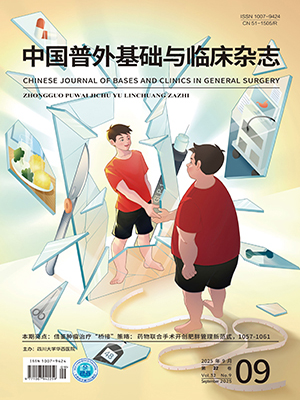| 1. |
Cao W, Chen HD, Yu YW, et al. Changing profiles of cancer burden worldwide and in China: a secondary analysis of the global cancer statistics 2020. Chin Med J (Engl), 2021, 134(7): 783-791.
|
| 2. |
中國抗癌協會乳腺癌專業委員會. 中國晚期乳腺癌臨床診療專家共識( 2018版). 中華腫瘤雜志, 2018, 40(9): 703-713.
|
| 3. |
Lyman GH, Somerfield MR, Bosserman LD, et al. Sentinel lymph node biopsy for patients with early-stage breast cancer: American society of clinical oncology clinical practice guideline update. J Clin Oncol, 2017, 35(5): 561-564.
|
| 4. |
Boughey JC, Suman VJ, Mittendorf EA, et al. Sentinel lymph node surgery after neoadjuvant chemotherapy in patients with node-positive breast cancer: the ACOSOG Z1071 (Alliance) clinical trial. JAMA, 2013, 310(14): 1455-1461.
|
| 5. |
Wetzig N, Gill PG, Espinoza D, et al. Sentinel-lymph-node-based management or routine axillary clearance? Five-year outcomes of the racs sentinel node biopsy versus axillary clearance (SNAC) 1 trial: assessment and incidence of true lymphedema. Ann Surg Oncol, 2017, 24(4): 1064-1070.
|
| 6. |
Kuehn T, Bauerfeind I, Fehm T, et al. Sentinel-lymph-node biopsy in patients with breast cancer before and after neoadjuvant chemotherapy (SENTINA): a prospective, multicentre cohort study. Lancet Oncol, 2013, 14(7): 609-618.
|
| 7. |
中國抗癌協會乳腺癌專業委員會. 中國抗癌協會乳腺癌診治指南與規范(2021年版). 中國癌癥雜志, 2021, 31(10): 954-1040.
|
| 8. |
Bromham N, Schmidt-Hansen M, Astin M, et al. Axillary treatment for operable primary breast cancer. Cochrane Database Syst Rev, 2017, 1(1): CD004561. doi: 10.1002/14651858.CD004561.pub3.
|
| 9. |
Beek MA, Verheuvel NC, Luiten EJ, et al. Two decades of axillary management in breast cancer. Br J Surg, 2015, 102(13): 1658-1664.
|
| 10. |
Zhang JQ, Montagna G, Sevilimedu V, et al. Longitudinal prospective evaluation of quality of life after axillary lymph node dissection. Ann Surg Oncol, 2022 Apr 1. doi: 10.1245/s10434-022-11623-z.
|
| 11. |
Sparano JA, Gray RJ, Makower DF, et al. Adjuvant chemotherapy guided by a 21-gene expression assay in breast cancer. N Engl J Med, 2018, 379(2): 111-121.
|
| 12. |
Piccart M, van’t Veer LJ, Poncet C, et al. 70-gene signature as an aid for treatment decisions in early breast cancer: updated results of the phase 3 randomised MINDACT trial with an exploratory analysis by age. Lancet Oncol, 2021, 22(4): 476-488.
|
| 13. |
Amin MB, Greene FL, Edge SB, et al. The Eighth Edition AJCC Cancer Staging Manual: continuing to build a bridge from a population-based to a more “personalized” approach to cancer staging. CA Cancer J Clin, 2017, 67(2): 93-99.
|
| 14. |
Allison KH, Hammond MEH, Dowsett M, et al. Estrogen and progesterone receptor testing in breast cancer: ASCO/CAP guideline update. J Clin Oncol, 2020, 38(12): 1346-1366.
|
| 15. |
楊文濤, 步宏. 第5版WHO乳腺腫瘤分類解讀. 中華病理學雜志, 2020, 49(5): 400-405.
|
| 16. |
劉月平. 國際乳腺癌Ki-67工作組Ki-67評估更新的主要內容解讀. 中華病理學雜志, 2021, 50(7): 704-709.
|
| 17. |
B?cker W. WHO classification of breast tumors and tumors of the female genital organs: pathology and genetics. Verhandlungen der Deutschen Gesellschaft fur Pathologie, 2002, 86: 116-119.
|
| 18. |
Ogston KN, Miller ID, Payne S, et al. A new histological grading system to assess response of breast cancers to primary chemotherapy: prognostic significance and survival. Breast, 2003, 12(5): 320-327.
|
| 19. |
李健斌, 江澤飛. 2019年CSCO BC指南更新要點解讀. 中國腫瘤外科雜志, 2019, 11(3): 155-160.
|
| 20. |
Provenzano E, Bossuyt V, Viale G, et al. Standardization of pathologic evaluation and reporting of postneoadjuvant specimens in clinical trials of breast cancer: recommendations from an international working group. Mod Pathol, 2015, 28(9): 1185-1201.
|
| 21. |
Krag DN, Anderson SJ, Julian TB, et al. Sentinel-lymph-node resection compared with conventional axillary-lymph-node dissection in clinically node-negative patients with breast cancer: overall survival findings from the NSABP B-32 randomised phase 3 trial. Lancet Oncol, 2010, 11(10): 927-933.
|
| 22. |
Tee SR, Devane LA, Evoy D, et al. Meta-analysis of sentinel lymph node biopsy after neoadjuvant chemotherapy in patients with initial biopsy-proven node-positive breast cancer. Br J Surg, 2018, 105(12): 1541-1552.
|
| 23. |
Ye BB, Zhao HM, Yu Y, et al. Accuracy of axillary ultrasound after different neoadjuvant chemotherapy cycles in breast cancer patients. Oncotarget, 2017, 8(22): 36696-36706.
|
| 24. |
Javid S, Segara D, Lotfi P, et al. Can breast MRI predict axillary lymph node metastasis in women undergoing neoadjuvant chemotherapy. Ann Surg Oncol, 2010, 17(7): 1841-1846.
|
| 25. |
Koolen BB, Valdés Olmos RA, Wesseling J, et al. Early assessment of axillary response with 1?F-FDG PET/CT during neoadjuvant chemotherapy in stage Ⅱ–Ⅲ breast cancer: implications for surgical management of the axilla. Ann Surg Oncol, 2013, 20(7): 2227-2235.
|
| 26. |
Samiei S, de Mooij CM, Lobbes MB I, et al. Diagnostic performance of noninvasive imaging for assessment of axillary response after neoadjuvant systemic therapy in clinically node-positive breast cancer: a systematic review and meta-analysis. Ann Surg, 2021, 273(4): 694-700.
|
| 27. |
Kantor O, Sipsy LM, Yao K, et al. A predictive model for axillary node pathologic complete response after neoadjuvant chemotherapy for breast cancer. Ann Surg Oncol, 2018, 25(5): 1304-1311.
|
| 28. |
Kim R, Chang JM, Lee HB, et al. Predicting axillary response to neoadjuvant chemotherapy: breast MRI and US in patients with node-positive breast cancer. Radiology, 2019, 293(1): 49-57.
|
| 29. |
Hurvitz SA, Martin M, Symmans WF, et al. Neoadjuvant trastuzumab, pertuzumab, and chemotherapy versus trastuzumab emtansine plus pertuzumab in patients with HER2-positive breast cancer (KRISTINE): a randomised, open-label, multicentre, phase 3 trial. Lancet Oncol, 2018, 19(1): 115-126.
|
| 30. |
Houssami N, Macaskill P, von Minckwitz G, et al. Meta-analysis of the association of breast cancer subtype and pathologic complete response to neoadjuvant chemotherapy. Eur J Cancer, 2012, 48(18): 3342-3354.
|
| 31. |
Myers SP, Ahrendt GM, Lee JS, et al. Association of tumor molecular subtype and stage with breast and axillary pathologic complete response after neoadjuvant chemotherapy for breast cancer. Ann Surg Oncol, 2021, 28(13): 8636-8642.
|
| 32. |
Lim DW, Greene BD, Look Hong NJ. Relationship between breast and axillary pathologic complete response in women receiving neoadjuvant chemotherapy for breast cancer. Ann Surg Oncol, 2021, 28(10): 5495-5506.
|
| 33. |
Samiei S, Simons JM, Engelen SME, et al. Axillary pathologic complete response after neoadjuvant systemic therapy by breast cancer subtype in patients with initially clinically node-positive disease: a systematic review and meta-analysis. JAMA Surg, 2021, 156(6): e210891. doi: 10.1001/jamasurg.2021.0891.
|
| 34. |
Kim J, Han BK, Ko EY, et al. Prediction of pathologic complete response on MRI in patients with breast cancer receiving neoadjuvant chemotherapy according to molecular subtypes. Eur Radiol, 2022, 32(6): 4056-4066.
|
| 35. |
Kuerer HM, Smith BD, Krishnamurthy S, et al. Eliminating breast surgery for invasive breast cancer in exceptional responders to neoadjuvant systemic therapy: a multicentre, single-arm, phase 2 trial. Lancet Oncol, 2022, 23(12): 1517-1524.
|




